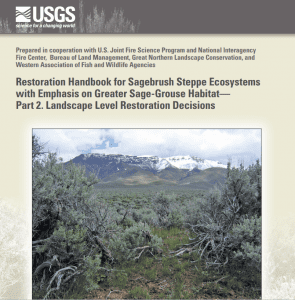Search Results:
View abstracts.
These abstracts of recent papers on rangeland management in the West were prepared by Charlie Clements, Rangeland Scientist, USDA Agricultural Research Service, Reno, NV.
View abstracts.
Abstracts of recent papers on climate change and land management in the West. Prepared by Louisa Evers, Science Liaison and Climate Change Coordinator, Bureau of Land Management, Oregon-Washington State Office.
View research brief.
This study shows that conifer removal for sage-grouse also benefits sagebrush-dependent songbirds. In the Warner Mountains of southern Oregon, Brewer’s sparrow abundance increased by +55% and green-tailed towhee jumped +81% following cuts. Annual increases each year post tree removal suggest that songbird use may increase even more with time. Abundances of species less dependent on shrublands including mountain bluebird and rock wren were unaffected by treatments.
View abstracts.
Abstracts of Recent Papers on Climate Change and Land Management in the West, Prepared by Louisa Evers, Science Liaison and Climate Change Coordinator, BLM, OR-WA State Office.
View handbook.
This handbook discusses concepts surrounding landscape and restoration ecology of sagebrush ecosystems and greater sage-grouse that habitat managers and restoration practitioners need to know to make informed decisions regarding where and how to restore specific areas, by providing:
- Descriptions of plant dynamics of sagebrush steppe ecosystems and their responses to major disturbances, fire, and defoliation.
- Introductions of the concepts of ecosystem resilience to disturbances and resistance to invasions of annual grasses within sagebrush steppe.
- Introductions to soils and ecological site information will provide insights into the specific plants that can be restored in a location.
- Descriptions of concepts of landscape ecology that aid decisions regarding habitat restoration.
- Overviews of restoration techniques for sage-grouse habitat restoration.
- Descriptions of the critical nature of monitoring for adaptive management of sagebrush steppe restoration at landscape- and project-specific levels.
View infographic.
This infographic developed by SageSTEP.org describes sagebrush steppe restoration prioritization and methods to benefit sage-grouse habitat.
View bibliography.
This bibliography reflects the growing interest in assisted migration, the intentional movement of plant materials in response to climate change, and provides a central foundation for collaboration in generating research questions, conducting studies, transferring and acquiring data, expanding studies to key species and geographic regions, and guiding native plant transfer in changing climates. It should inform management as the mismatch in rates between climate change and plant migration and adaptation pose significant challenges for natural resource managers, especially when scientific information often lags behind the demand for management actions.
View posters and postcards.
The Sage Grouse Initiative developed posters and postcards designed to promote conversations about the importance of taking care of sagebrush community plant health and diversity, above and below ground.
View handbook.
This handbook is intended to assist decision makers in determining landscape objectives, to identify and prioritize landscape areas where sites for priority restoration projects might be located, and to aid in ultimately selecting restoration sites guided by criteria used to define the landscape objectives. The landscape restoration decision tool is structured in five sections that should be addressed sequentially. Each section has a primary question or statement followed by related questions and statements to assist the user in addressing the primary question or statement.



